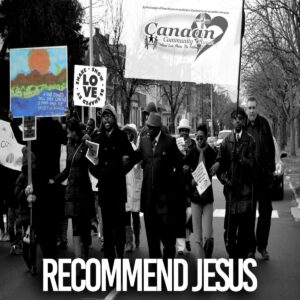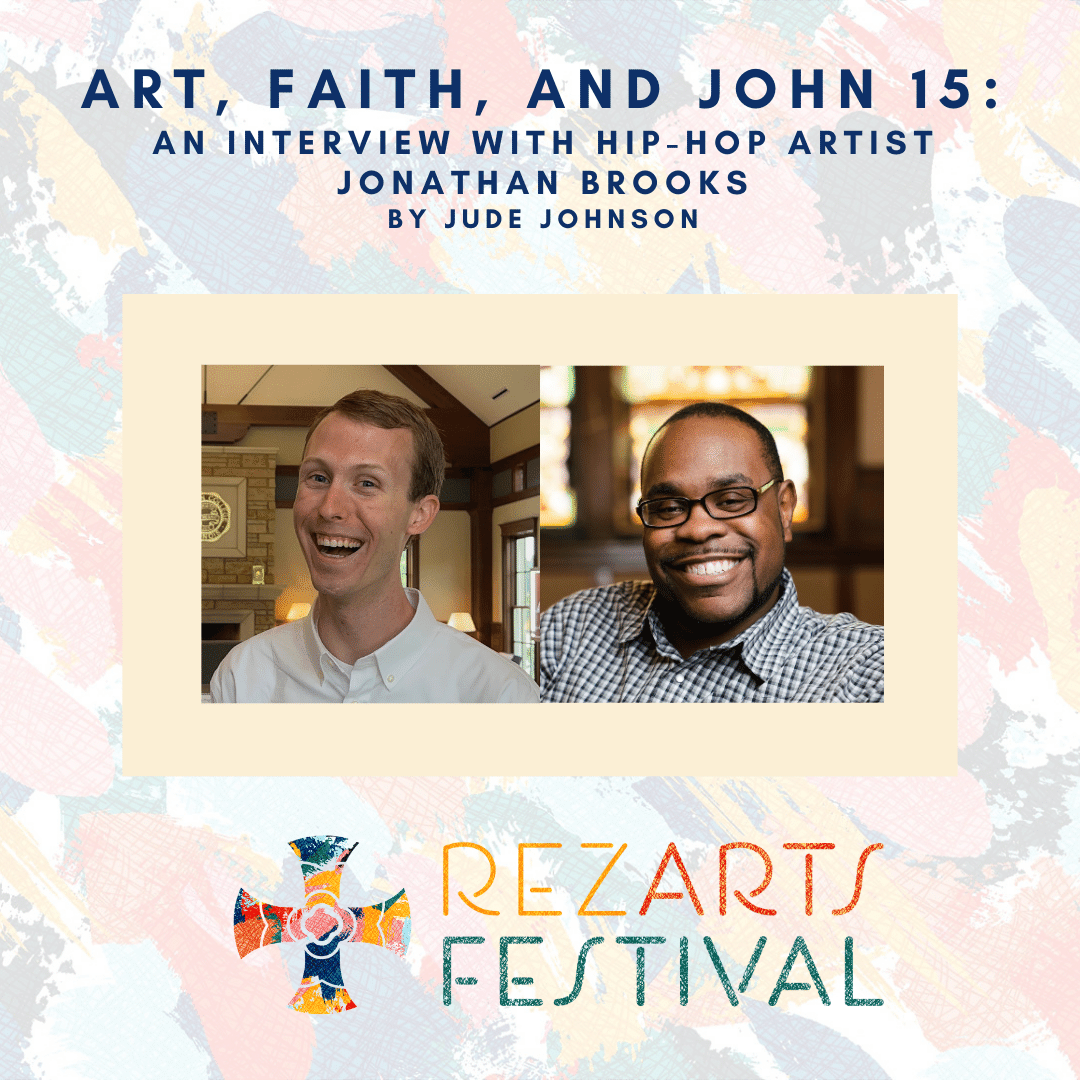 Wheaton College senior Jude Johnson has served as an intern in RezArts for the past few months. He has been helping develop this year’s RezArts Festival–our church-wide celebration of the arts–and creating resources for artists in our community. As part of his effort to produce inspirational creative resources, Jude recently interviewed hip-hop artist and pastor Jonathan Brooks about his thoughts on art, faith, and John 15:1-8 (this year’s theme for the Festival). Affectionately known as “Pastah J,” Jonathan Brooks currently serves as lead pastor at Lawndale Community Church on the West side of Chicago and formerly served as pastor of Canaan Community Church on the South side. Jude’s takeaway from the interview: Artists need the Church, and the Church needs art–particularly hip-hop.
Wheaton College senior Jude Johnson has served as an intern in RezArts for the past few months. He has been helping develop this year’s RezArts Festival–our church-wide celebration of the arts–and creating resources for artists in our community. As part of his effort to produce inspirational creative resources, Jude recently interviewed hip-hop artist and pastor Jonathan Brooks about his thoughts on art, faith, and John 15:1-8 (this year’s theme for the Festival). Affectionately known as “Pastah J,” Jonathan Brooks currently serves as lead pastor at Lawndale Community Church on the West side of Chicago and formerly served as pastor of Canaan Community Church on the South side. Jude’s takeaway from the interview: Artists need the Church, and the Church needs art–particularly hip-hop.
By Jude Johnson
 As an undergraduate architecture student at Tuskegee University, Pastah J saw his vocation as that of an artist. Art was the lens through which he viewed the world–and his place in it. But God had other plans for using his creative talents to call out and equip the Church, from authoring Church Forsaken: Practicing Presence in Neglected Neighborhoods (InterVarsity 2018) to teaching at Northern Seminary. In addition, Pastah J has recorded numerous hip-hop and gospel records and has contributed to multiple books and blogs.
As an undergraduate architecture student at Tuskegee University, Pastah J saw his vocation as that of an artist. Art was the lens through which he viewed the world–and his place in it. But God had other plans for using his creative talents to call out and equip the Church, from authoring Church Forsaken: Practicing Presence in Neglected Neighborhoods (InterVarsity 2018) to teaching at Northern Seminary. In addition, Pastah J has recorded numerous hip-hop and gospel records and has contributed to multiple books and blogs.
Hip-hop is an artistic medium which some people would not immediately associate with the Church. How do you feel like hip-hop can be useful and reveal certain truths that other artistic media can’t?
I think you have to look at the origins of hip-hop in order to understand [the answer to that question] and how they interact with the origins of Christianity. … [Hip-hop] comes from the margins. It is a medium created by an oppressed people in New York (from The Bronx) dealing with disinvestment, marginalization, being forgotten, and being looked at as unimportant. They used this artistic medium as a way of refusing to be silenced.…
Jesus’ life is about honoring those on the bottom of Empire, those who’ve been marginalized or who are considered “less than.” And you see Jesus spend all of his time lifting up those who have often been forgotten throughout his ministry. And that’s what hip-hop does. … I look at [the origins] of hip-hop, and they line up perfectly with what Jesus is doing in the New Testament–and that’s lifting up the marginalized. I see [this as] Jesus’ mission statement:
The Spirit of the Lord is upon me,
because he has anointed me
to proclaim good news to the poor.
He has sent me to proclaim liberty to the captives
and recovering of sight to the blind,
to set at liberty those who are oppressed,
to proclaim the year of the Lord’s favor. (Luke 4:18-19, ESV)
This is what hip-hop is doing. It’s saying, “Hey, we want to lift up people who’ve been traditionally put down.” And this medium has grown to be one of the greatest artistic expressions in the world.

How has John 15 impacted your life?
I love this passage. It’s one of those passages that is connected with a real life experience for me. As an African American man, my connection with ground, soil, planting, and growing was marginalized by the fact that every image I saw growing up of African Americans in the soil and in the ground was connected to slavery and enslaved people. And so I had a resistance to the imagery…
My wife really freed me up. My wife, Micheál, who does urban agriculture for a living, really encouraged me to put my hands in the soil. And I realized what I was missing out on, and that there was life in the soil. So when you think about John 15–this idea of Jesus using the imagery of the vine with the Father as the gardener who prunes back things that will resist growth–it really comes alive when you have to actually do that, when you realize that certain things have to be cut off even if they look like they’re good when their growing.
How do you see Jesus’ metaphor of God as gardener, Christ as vine, and us as branches relating specifically to the Christian artist and the artistic process?
I think it’s clear that Jesus, first and foremost, is giving a nod to the artist by using everyday imagery to explain the Christian and the connection to Christ. And I think Jesus does that all throughout his preaching. He gives a nod over and over and over again to imagery, to vision, to using imagery that people can relate to and understand as a way of relating it to the kingdom and to Christianity. And in John 15 he is doing it again: This passage is giving a nod to the farmer, to the everyday person–that what you do is important.
There is this idea of being connected to the vine, and that when you’re not connected to the vine, you’re not connected to your source. As artists we have to think of what our source is and what our connection is. Our connection to God is our art, our connection to the world is our art. And if we allow that to be marginalized by others, or if we disconnect from it ourselves, we disconnect from the way God wants to use us. So I think a lot of artists find themselves disconnecting from art in the church realm. We’ll be artists in the world, but we won’t bring our art into the church because we feel like, “Oh, people won’t understand it” or “It’s a little more foreign here.” I think that is a part of the reason why pieces of the Church are so disconnected from God. It is because we’re not bringing the fullness of who we are into these spaces. And we need artists. We need artists who think outside the box. We need artists who will bring the beauty and creativity of who they are into Christian spaces, so that we are able to see God in new ways and understand God in different ways.
You can learn more about Pastah J’s work at pastahj.com. Check out his recent collaboration with Chicago rapper Corey Mix or his record with Canaan Community Church. Find him on X or Instagram @pastahj.
Jude Johnson, an Aequitas Urban Leadership Fellow at Wheaton College, studies art history and English literature. He has served with RezYouth and works to foster artistic community at Church of the Resurrection.
Photo of Pastah J from Trinity Christian College



